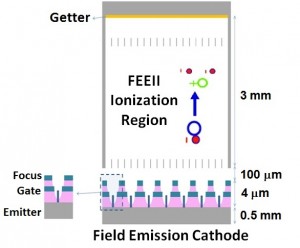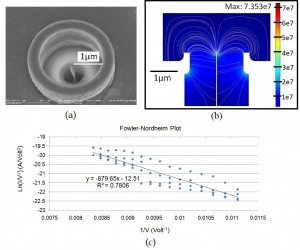Electron-impact-ionization Pump Using Double-gated Isolated Vertically Aligned Carbon Nanotube Arrays
- Category: Energy, MEMS & BioMEMS, Nanotechnology
- Tags: Luis Velásquez-García, Vivi Jayanty
There is a need for microscale vacuum pumps that can be readily integrated with other MEMS and electronic components at the chip-scale level. Vacuum pumps exhibit favorable scaling and are promising for a variety of applications such as portable mass spectrometers [1] and vacuum amplifiers. This project aims to develop the technology for a micro-fabricated electron-impact-ionizer pump. The micropump consists of a field-emission electron source that is an array of double-gated isolated vertically aligned carbon nanotubes (VA-CNTs), an electron-impact-ionization region, and an ion implantation getter, as shown in Figure 1. The pump works as follows: first, electrons are field-emitted from the VA-CNT array; then, the electrons are accelerated at a bias voltage that maximizes the probability of collision with neutral gas molecules, this way achieving ionization by fragmentation of the molecules; finally, ions are implanted into the getter.
In a double-gated field-emitter array, the first gate (extractor) is used to modulate the tunneling of electrons out of the tip, while the second gate (focus) is biased at a lower voltage than the first gate to focus the emitted electrons and to collect the back-streaming ions, thus protecting the tip [2] . As part of this work, we designed and fabricated single-gated isolated VA-CNT field-emission arrays, shown in Figure 2(a), to quantify the effectiveness of the field emitter-extractor diode to enhance the electric field on the emitter tip (i.e., estimate the extractor field factor), through experiments and simulations using the commercial software COMSOL. Figure 2(b) shows the solution of electric field using the same geometry of the device we fabricated. Each emitter has a 15-nm tip radius and 2-µm height with a 1-µm aperture from a single gate. From the simulation results we obtain an extractor field factor of 7.35×105V/cm. Figure 2(c) is the experimental FN plot of an array of ~10,000 single-gated emitters. From the slope of the plot we estimate a field factor of 7.8×105V/cm, which is in good agreement with the prediction of the extractor field factor from the COMSOL simulation.
- Figure 1: Electron-impact-ionization pump structure consists of a field-emission cathode (CNTs, an extractor gate and a focus gate), an electron-impact-ionization region (length of L=3mm) and an ion-implantation getter.
- Figure 2: (a) SEM of single-gated isolated VA-CNT. (b) The solution of the electric field for an emitter with 15-nm tip radius, 2-µm height, and 1-µm gate aperture. A field factor (βG) of 7.35×105 V/cm is obtained. (c) The Fowler-Nordheim plot for an array of ~10,000 emitters. A field factor (βG) of 7.8×105 V/cm is calculated.
- K. H. Gilchrist, C. A. Bower, M. R Lueck, J. R. Piascik, B. R. Stoner, S. Natarajan, C. B. Parker, and J. T. Glass, “A novel ion source and detector for a miniature mass spectrometer,” IEEE Sensors, pp. 1372-1375, Oct. 2007. [↩]
- L. –Y. Chen, L. F. Velásquez-García, X. Wang, K. Cheung, K. Teo, and A.-I. Akinwande, “Design, fabrication and characterization of double-gated vertically aligned carbon nanofiber field emitter arrays,” in Vacuum Nanoelectronics Conference, 2007, pp. 82-83. [↩]

